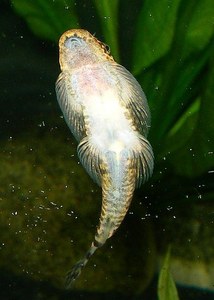Pseudogastromyzon fangi
Summary
Scientific name: Pseudogastromyzon fangi (Nichols, 1931)
 Common name: None known
Common name: None known
Synonyms: Crossostoma fangi
Distribution: China: Guangdong Province - Zhujiang River, Xiangjiang River, Changjiang River.
Sexual Dimorphism: None known
Maximum size: 4 inches (10cm)
Similar to: Pseudogastromyzon myersi, Pseudogastromyzon peristictus, Pseudogastromyzon tungpeiensis
Care: Inhabits fast flowing streams over boulders. Aquarium must duplicate these conditions as fish have very high oxygen requirements.
See: Hillstream Loaches - The Specialists At Life In The Fast Lane for more detailed explanation of aquarium setup.
With all sucker-type hillstream species, care is broadly the same. All need excellent water-flow and aeration, numerous rocky hiding places and smooth pebbles and boulders to graze over. Lighting should be bright to encourage algal growth in the aquarium. Plants are not necessary as the fish do not normally encounter them in the wild, but they will help with water-quality. Suitable plants for high-flow environments are Anubias and Microsoreum. These will grow on rockwork or driftwood.
Feeding: Good quality flake, sinking pellets, algae wafers, thawed frozen bloodworm, Mysis shrimp, blanched spinach, kale, natural algae an advantage.
Water parameters: pH:7.0-8.0. Hardness: Medium. Max dh:12
Temperature: 68ºF to 75ºF(20-23.8°C)
Breeding: Not known in aquarium
 |
Notes:
 In a properly set up aquarium they are lively and entertaining inhabitants, almost constantly on the move. The fish eat micro-organisms growing on the rocks and also algae. There should be bright lighting to encourage algae growth. This species tends to enjoy searching in the gravel for food, more than most hillstream species. Pseudogastromyzon fangi is not a common import but may show up in pure shipments or as a contaminant with other Chinese hillstream loaches.
In a properly set up aquarium they are lively and entertaining inhabitants, almost constantly on the move. The fish eat micro-organisms growing on the rocks and also algae. There should be bright lighting to encourage algae growth. This species tends to enjoy searching in the gravel for food, more than most hillstream species. Pseudogastromyzon fangi is not a common import but may show up in pure shipments or as a contaminant with other Chinese hillstream loaches.
It is easily distinguishable from the more commonly seen Pseudogastromyzon cheni by the larger dorsal having more beautiful yellow coloration and lacking the red border seen in P. cheni and finer patterning to the body.
Photo Gallery
Click to view all images of this species! |
|
Document Actions


